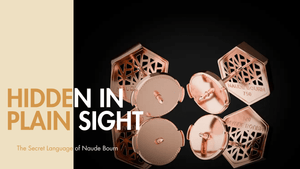In recent years, lab-grown diamonds have become a sought-after choice for consumers who desire the brilliance of diamonds without the environmental and ethical concerns associated with traditional mining. Lab-grown diamonds are not only eco-friendly but also offer a stunning, luxurious appeal at a more accessible price point. At Naude Bourn, we take pride in offering lab-grown diamonds crafted through precision and advanced technology, providing our customers with diamonds that are every bit as real as those sourced from deep within the earth.
In this post, we’ll explore the fascinating process of how lab-grown diamonds are made, why they are as real as mined diamonds, and the advantages they offer. Whether you're interested in science or simply intrigued by the ethical and sustainable choices behind lab-grown diamonds, this guide provides an inside look.
What Are Lab-Grown Diamonds?
Lab-grown diamonds, also known as synthetic or cultured diamonds, are diamonds produced in controlled laboratory environments rather than formed naturally beneath the earth’s surface. Using advanced technology, scientists can replicate the high-pressure, high-temperature conditions that produce natural diamonds, resulting in diamonds with identical physical, chemical, and optical properties to their mined counterparts.
Unlike imitation stones like cubic zirconia or moissanite, lab-grown diamonds are 100% real diamonds. At Naude Born, we are dedicated to educating our customers on the value of lab-grown diamonds, allowing them to make informed choices that align with their ethical and environmental standards.
The Process of Making Lab-Grown Diamonds
The creation of lab-grown diamonds involves cutting-edge technology and precise scientific processes. Currently, two primary methods are used to produce lab-grown diamonds: High Pressure High Temperature (HPHT) and Chemical Vapor Deposition (CVD). Each method replicates the natural conditions required to grow a diamond, yielding stones that are as brilliant and durable as their mined counterparts.
High Pressure High Temperature (HPHT) Process
The HPHT method closely mimics the natural forces that produce diamonds beneath the earth. Here’s how it works:
1. Preparing the Carbon Seed: The process starts with a tiny seed of carbon. This seed is placed into a chamber, along with a metal catalyst, such as iron or nickel, which helps facilitate diamond growth.
2. Applying Intense Pressure and Temperature: The chamber is subjected to intense pressure (approximately 1.5 million pounds per square inch) and extreme temperatures exceeding 1,500 degrees Celsius. These conditions replicate the environment found deep within the earth’s mantle.
3. Crystallization: Under these conditions, the carbon seed begins to crystallize, forming layers of diamond around it. The process takes several weeks, during which the diamond structure grows layer by layer until it reaches the desired size.
4. Cooling and Finishing: The diamond is slowly cooled, allowing it to stabilize. After this, it’s cut, polished, and prepared for use in luxury jewelry.
Chemical Vapor Deposition (CVD) Process
The CVD method, while newer, is widely used for producing gem-quality diamonds. The process involves growing the diamond in a carbon-rich gas chamber under specific conditions. Here’s how it works:
1. Placing the Diamond Seed: A thin slice of diamond seed, typically made from HPHT-grown diamond, is placed inside a vacuum chamber.
2. Introducing the Carbon-Rich Gas: Gases like methane and hydrogen are pumped into the chamber and exposed to high temperatures. This gas mixture breaks down, causing carbon atoms to separate.
3. Growing the Diamond Layer by Layer: The carbon atoms attach to the diamond seed, forming a diamond crystal layer by layer. This process continues until the diamond reaches the desired size, which may take several weeks.
4. Post-Growth Treatment: Once the diamond is grown, it may undergo further heat or pressure treatments to enhance its color and clarity.
Both HPHT and CVD diamonds are chemically and structurally identical to natural diamonds. Naude Bourn's collection exclusively uses diamonds that meet rigorous quality standards, ensuring every piece is a luxurious and ethical choice.
Advantages of Lab-Grown Diamonds
Lab-grown diamonds offer a range of benefits that extend beyond aesthetics. Here are some reasons why lab-grown diamonds are a remarkable choice
Environmental Impact: Unlike traditional diamond mining, which often leads to significant land disruption and energy consumption, lab-grown diamonds reduce environmental strain. They require less water, land, and energy, resulting in a lower carbon footprint.
Ethical Sourcing: With lab-grown diamonds, there’s no risk of purchasing conflict or ‘blood diamonds.’ Consumers can enjoy their jewelry with peace of mind, knowing their purchase supports a cruelty-free and ethically sound industry.
Quality and Affordability: Lab-grown diamonds offer the same durability, brilliance, and fire as natural diamonds but at a lower price point. This accessibility allows customers to own larger, higher-quality stones within their budget.
Customization and Innovation: Lab-grown diamonds are not limited by natural formation timelines, allowing greater control over characteristics like size, color, and clarity. This flexibility makes lab-grown diamonds an exciting choice for jewelers, designers, and anyone seeking unique, customizable pieces.
Naude Bourn is dedicated to providing diamonds that meet these standards of excellence, ensuring that every piece combines luxury with a mindful approach to sourcing.
Why Choose Lab-Grown Diamonds from Naude Bourn
Choosing lab-grown diamonds from Naude Bourn means embracing a brand that values both beauty and responsibility. Our diamonds are chosen not only for their quality but also for their ethical production. Here’s what sets us apart:
Commitment to Quality: Each Naude Bourn diamond is carefully selected and inspected to meet the highest standards. We ensure that every diamond has the same beauty and brilliance you would expect from traditional diamonds.
Ethical Sourcing: At Naude Bourn, we’re dedicated to offering an alternative to mined diamonds without sacrificing quality. Our lab-grown diamonds are a responsible choice, free from the complications of unethical sourcing.
Luxurious and Sustainable: We believe that luxury can and should be sustainable. With Naude Bourn’s lab-grown diamonds, customers can own beautiful jewelry that aligns with their values, making a positive impact without compromising elegance or beauty.
With our commitment to transparency, we want you to know exactly where your diamonds come from and why they’re an exceptional choice.
Lab-Grown Diamonds: The Future of Luxury Jewelry
Lab-grown diamonds are redefining luxury by combining beauty, quality, and ethics. Through sophisticated processes like HPHT and CVD, these diamonds are crafted with care and precision to rival traditional stones in every way. By choosing lab-grown diamonds from Naude Bourn, you’re making a choice for a brighter, more sustainable future—without compromising on brilliance or elegance.
Explore Naude Bourn's collection today to discover the enduring allure of lab-grown diamonds, a choice as responsible as it is stunning. Make your next piece of luxury jewelry an expression of both your style and your values with Naude Bourn.





